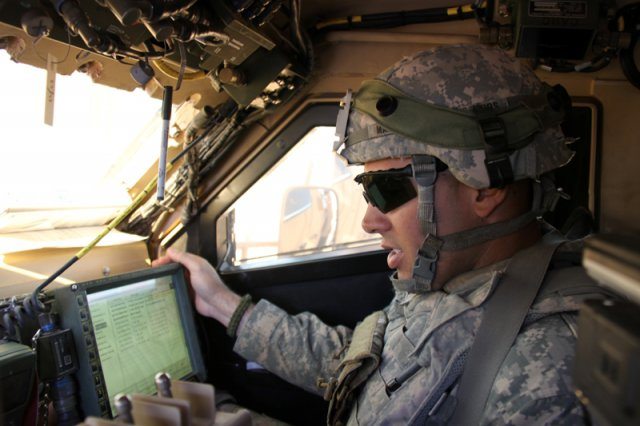The Army’s largest ever network field exercise rolled into action today, as more than 4,000 Soldiers began to execute a rigorous scenario designed to measure the performance and operational value of advanced tactical communications equipment under real-world conditions.
Spread across a battlespace the size of Delaware, the Network Integration Evaluation, or NIE 12.2, will challenge the 2nd Brigade, 1st Armored Division, to maintain network connectivity as units maneuver vast distances against a hybrid threat. In the notional country of Attica, they will encounter a complex mix of an opposing nation’s army, insurgents, civilians, a host-nation army, criminals and others, all against the backdrop of mountainous desert terrain marked by scorching temperatures and swirling dust.
“The conditions are pretty tough down here, and the distances we’re covering are truly astounding, so this will be a truly effective and realistic workout for the systems,” said Col. Dan Pinnell, who commands the 3,800 Soldiers of the 2/1 AD. “Frankly, for me it’s a better evaluation when you’re doing realistic stuff, when you are up and moving aggressively at a very fast tempo.”
NIE 12.2 is the third in a series of semi-annual evaluations designed to rapidly mature and further integrate the Army’s tactical communications network. It differs from previous exercises in size, scope and as the final “checkout” for Capability Set 13, the first integrated group of network technologies that will be fielded to brigade combat teams beginning this fall.
Capability Set 13 is anchored by the Warfighter Information Network-Tactical, or WIN-T Increment 2, a major upgrade to the tactical communications backbone that will enable mission command on-the-move and extend satellite communications to the company level. Much of the scenario for NIE 12.2 was driven by requirements for the Initial Operational Test and Evaluation for WIN-T Increment 2, said Lt. Col. John Kline, chief of operations for the Brigade Modernization Command. The BMC, along with the System of Systems Integration Directorate and Army Test and Evaluation Command, form a Triad of organizations that executes the NIEs.
For example, to ensure the network can function when nodes are spaced out at great distances, the scenario requires different elements of the brigade to occupy various stretches of White Sands Missile Range by the end of the exercise. It also calls for brigade and battalion tactical operations centers to “jump” or relocate several times during the test, so commanders can evaluate the capabilities of mission command on-the-move.
But while there are certain “anchors” built into the scenario to ensure the Army obtains the necessary test data, Pinnell and his troops will have a great amount of flexibility for “free play” operations based on mission conditions and their own decisions, Kline said.
“We have really moved to a dynamic free play exercise that has control mechanisms in it to ensure we make our requirements for test and evaluation, but provides a much more operational feel to the environment,” said Col. Robert Menti, BMC’s training evaluation division chief. “We are also implementing for the first time the simulation wraparound, so that the unit is operating in context with larger organizational formations.”
That is the role of the 101st Airborne Division, which will serve as the headquarters element to 2/1 AD by issuing orders and monitoring operations over the WIN-T network from Fort Campbell, Ky. For further realism, other “brigades” within the division are represented through simulated data traffic on the network. Intelligence and mission command systems have also been populated with information about Attica and its inhabitants, a baseline that 2/1 AD Soldiers will add to as they collect intelligence at the tactical edge and transmit it over the network.
Their targets will be a hybrid threat comprised of approximately 600 Soldiers from the 2nd Engineer Battalion playing different roles in the opposing force, or OPFOR. Occupying 11 different villages, the OPFOR will also have the freedom to behave in unpredictable ways, said Lt. Col. Andre Balyoz, 2nd Engineer Battalion commander.
“If, for example, a (2/1 AD) unit moves into a village and they’re interfering with civilians in a way that is not appreciated, then the civilians could demonstrate, or riot, or the insurgents might take advantage of it,” he said. “We’re here to support the test, (and) the purpose of this whole exercise is to test equipment. So my intent is to fight against the 2/1 AD and try to defeat them.”
In addition to the IOT&E for WIN-T Increment 2, NIE 12.2 will also serve as the formal operational test for the Manpack component of the Joint Tactical Radio Systems or JTRS Handheld, Manpack, Small Form Fit, or HMS system. The exercise also includes informal evaluation of 37 other network and non-network systems, in addition to the Capability Set 13 baseline. It concludes on June 8.
“A number of factors come into play, but I think you’ll find a much more fluid environment that is more challenging for the chain of command,” said Brig. Gen. Randal Dragon, BMC commander. “You’ll see a very mobile exercise.”











